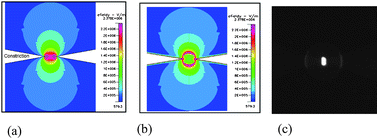The enhancement of signal sensitivity through the scaling-down of sensors presents mass transport limitations that can arrest the sensitivity gains obtained as a result of miniaturization. To alleviate these limitations, we study the application of constriction-based dielectrophoresis methods to enhance transport through pre-concentration of target DNA in the vicinity of the diffusion layer of the sensor, on which capture probe DNA molecules were immobilized. We demonstrate that constriction-based DEP pre-concentration was not impeded by scaling-down of the sensor, as long as the sensor electrode was composed of nanostructured edges and was coupled to an equally scaled down insulating constriction within a microfluidic channel to enhance the focusing effects of the constrictions and edges. Furthermore, as a result of the high focusing fields, pre-concentration of single-stranded target DNA occurred in the vicinity of the sensor pad within the relatively high ionic strength buffers required for DNA hybridization, with minimal degradation of capture probe molecules. Finally, constriction-based DEP resulted in an almost immediate pre-concentration of target DNA in the vicinity of the sensor electrode diffusion layer, resulting in a ten-fold enhancement of the DNA hybridization kinetics at target concentration values down to the sensitivity limit of 10 pM for the sensor platform.

You have access to this article
 Please wait while we load your content...
Something went wrong. Try again?
Please wait while we load your content...
Something went wrong. Try again?


 Please wait while we load your content...
Please wait while we load your content...